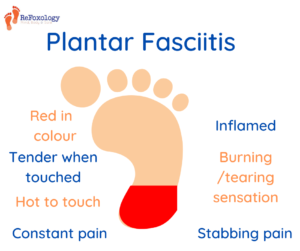
So what is planter fasciitis,? what are the causes?, signs?, what can you do to ease it? how can a reflexology treatment help with the pain?
What is Plantar Fasciitis?
It is pain in the heel.
The plantar fascia is a thick band of tissue that runs from your heel, along the arch to the base of each toe. Its role is to stabilise the foot and act as a shock absorber when walking. (BUPA May 2022)
Causes
It usually occurs when there is too much pressure placed on this plantar fascia tissue causing it tear.
It is very common and often occurs in people who:
- Participate in high impact sports such as running
- Stand/walk for long periods of time
- Are overweight
- Are pregnant
- Have high arches or flat feet
Signs of Plantar Fasciitis
- Stabbing pain in the heel
- Burning and or tearing sensation in the heel
- Inflammation in the heel
- Heel feels hot to touch
- Pain in heel is generally consistent throughout the day – both weight and non-weight bearing
- Heel is red in colour
- Tender to touch
If you do not have all of these symptoms it is likely you do not have plantar fasciitis but could be a referral pain from the muscles or joints in the hip, back or buttocks. If this is the case, reflexology can help identify the area related to the referral pain. These areas will be the focus of the treatment and appropriate stretches will be provided to continue at home.
How Can You Ease Your Plantar Fasciitis?
Sam Belyea (American Reflexologist) suggests that using the METH method is beneficial for tissue inflammation/injury.
M = Movement – circle, flex and extend your feet
E = Elevation – when lying down raise your legs above your heart
T = Traction – massage the bottoms of your feet/heal with your hands, tennis ball or roller
H = Heat – apply a heat pack to your feet for approximately 20-minutes up to 3-times a day
You may also wish to consider:
- Not standing/walking for long-periods of time
- Your footwear are they supportive and cushioned?
- Participating in lower impact sporting activities
- Your weight – can you reduce it?
- Calf and plantar fascia stretches. Here are a couple of links to websites which specific stretches nhsaaa and healthline
You may wish to seek medical advice from your local GP, podiatrist, or chiropodist if the pain continues for more than 6-weeks.
How Can Reflexology Help Plantar Fasciitis?
During a reflexology treatment the whole foot will be worked to re-balance the body as plantar fasciitis may be linked to your physical or emotionally. However, there will be a specific focus on the lower body reflexes. During a treatment the METH method is applied and is a great way to improve circulation and ease the pain. It is applied as follows:
Movement – your feet are moved gently forward/backward and rotated to free the energy and assess the movement in the foot.
Elevation – you are laid flat on the couch with your legs raised.
Traction – occurs when applying pressure to your feet using various reflexology techniques
Heat – occurs when applying pressure to the points on the feet.
Following a treatment, you will be advised on stretches that you can carry out at home and how you can use a ball/roller to help stretch out the plantar fascia.
My clients who have had plantar fasciitis have found regular weekly reflexology sessions have really helped relieve the pain in their heel, they are walking easier and feel happier in themselves.
If you would like to book a treatment or would like to have a chat how reflexology can help you, please contact Nicola on 07889137168 or email nicola@refoxology.co.uk
